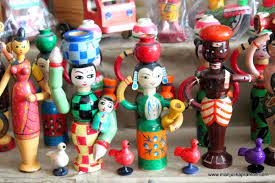Nikunja Bihari Sahu
Prime Minister, Mr Narendra Modiji, in one of his Man Ki Baat programmes, emphasised the need for promoting Indian toys and called upon all the stake holders to play big role to become global manufacturing hubs to make the country self-reliant in this promising sector. The subsequent show-casing of the Toy Fair in New Delhi from February 27 to March 2, 2021 is a strong message to revisit and boost the toy sector through which our rich cultural heritage can be best reflected to the world at large.
In the lucrative global toy market, India’s contribution at present, however, is unimpressive. India’s toy market stands at around $450-500 million which is about 0.5% of the world toy market of around $90 billion value. Currently, a huge 85% of Indian toys are imported ones of which the Chinese market account for a major share.
The history of toys in India dates back to the Indus Valley Civilization around 5,000 years ago. The earliest toys included whistles shaped like birds, toy monkeys that could slide down a string and small carts which were made from materials found in nature such as wood, clay and rocks.
There was a time when toys like rattlers, pull carts, dolls, stackers, building blocks, stuffed toys, train sets were children’s best friends during the long, hot and dreary summer breaks which could arouse a child’s curiosity for hours. Today, however, the market is brimming with a variety of factory-made toys engineered with modern materials and technologies. Moreover, children are now over burdened with assignments from schools so that they hardly find any time to devote to toys. Moreover, the arrival of soft games from computer and smart phone platforms had made the situation worse by getting children distracted from conventional toys.
Toys generally fuel the fancies of children as they try to manipulate them in a variety of modes to get different effects. This inculcates scientific enquiry and foster creative talents in the minds of children. A good toy should attract a child’s mind and provide the scope for exploring and extending its potentials. In this sense, a toy should be partly incomplete and should provide a scope to the children to be engaged in hands-on and minds-on activities to supplement the missing concept with one’s own ingenuity. A toy should not be simply judged by its cost or source of foreign origin, rather by its impacts on the minds of children for nurturing their creative talents. An appealing toy should not subdue, veil or wither a child’s imagination, rather become a part of his resourcefulness capability. Above all, the toys should be such that in their presence the childhood would bloom and smile!
In the National Education Policy a lot of attention has been given on the impact of toys on different aspects of a child’s life for blossoming his innovativeness and creativity spirit. Learning while playing, doing while learning, learning to make toys, visiting toy factories- all these have been made integral part of the curriculum.
There has been a rich tradition of local toys in our country. There are many talented and skilled artisans who possess expertise in making good toys. The dancing doll toys of Tanjavur and the Etikoppaka toys of Vishakhapatnam are to mention a few. Driven by a huge consumer base, India represents an important market in the world toy industry. Moreover, the country has a very large young mass with around half of the total population under the age of 25. The easy availability of raw materials for toy making, the vast support and service base and the large work force comprising of skilled artisans and manpower would help India become one of the leading global players in this sector. The middle class population, in particular, has shown strong consumerism demand in the country for recreational and pastime products. These have all contributed to the prospect of a flourishing toy industry in our country in days to come.
The writer is an Education Officer, Regional Science Centre, Bhopal.







































